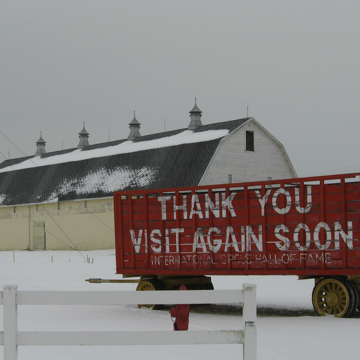You are here
International Circus Hall of Fame
Now the International Circus Hall of Fame, this property was previously used as winter quarters by Benjamin Wallace, the American Circus Corporation, and the Ringling Brothers’ Circus between 1892 and 1938, The site is located near the Wabash River, east of the city of Peru, seat of Miami County, Indiana. Peru's renown as “Circus City” began with Benjamin Wallace, a Civil War veteran who operated a livery stable. Beginning in the 1880s, Wallace acquired the remains of several circuses at auctions, and, in the spring of 1884, set out from Peru with “Wallace and Co.’s Great World Menagerie, Grand International Mardi Gras, Highway Holiday Hidalgo, and Alliance of Novelties.” This grandiosely named but relatively small one-ring show toured Virginia and Kentucky and enjoyed an excellent season. He had nine “cars” the next year.
Today, the primary buildings on the site date to the 1920s, a period of great prosperity for the circus industry. The only structure to predate Wallace’s 1892 purchase of the property was the Godfrey house, a mid-nineteenth-century farmhouse enlarged during Wallace’s ownership to serve as a dining hall for the workmen who quartered in the bunkhouses situated behind it. The Wagon Shop (1922), and the Elephant, Hippo, and Cat Barn (1923), are both grand wooden structures, approximately 150 feet in length, 72 feet in width, and 40 feet in height. Both buildings feature gambrel roofs and one-story wings constructed with concrete masonry blocks; the wings within the Wagon Shop were designed to house the circus wagons and machinery, while those of the Elephant, Hippo, and Cat Barn featured stalls to house the circus animals. Linking to the latter building is the Tiger, Lion, and Bear Barn. The two-story concrete structure features small windows situated high on the walls in order to keep the animals safely confined within the building. Standing adjacent to the road is the Circus Farm Office, a simple one-story frame cottage.
The Wallace Farm was purchased in 1913 by a syndicate, the Hagenbeck-Wallace Circus, and then by the Ringling Company in 1929. The Ringling Brothers sold the quarters in 1941, the same year that a fire on the site destroyed many of the ornate circus vehicles. Emil Shram, the former president of the New York Stock Exchange, purchased the Circus Farm in 1944 and removed most of the circus equipment and transportable apparatus, converting the property into a traditional working farm.
Over time many of the original circus buildings burned, and others were disassembled to accommodate the successive needs of the farm. These included the 425-foot-long Wagon and Baggage Shed, the John Robinson Stable east of the house, the bunkhouses, a wagon storage barn to the southeast of the house, and a series of corrals and pony stables to the northwest of the larger barns. The Paint Shop was deconstructed in 1941, the Sells-Floto and Hagenback Horse Stables both burned down in 1946, and the Ring Barn was torn down in 1958. A former residence once stood adjacent to the Godfrey House, and was originally used by the Ringlings; it was torn down and replaced with a swimming pool when the Ringlings sold the property.
In 1981, a group of historians from Peru learned that the historic pieces from the Circus Hall of Fame in Sarasota, Florida, were for sale. Intent on preserving the circus artifacts and concerned that they might be auctioned off separately, several Indiana residents, businesses, and state government offices contributed to the acquisition of the entire collection and brought it to Peru. Several other items have since been added to the original Sarasota collection and are displayed on the site. The museum exhibits posters, wagons, and models, including a miniature replica of the 1934 Hagenbeck-Wallace Circus. Open seasonally to visitors, the International Circus Hall of Fame also hosts the Big Top Circus, a professional circus with performers from around the world.
References
Ballard, C.E. The Ballards in Indiana. Peru, IN: C.E. Ballard Literary Trust, 1984.
Bradbury, Joseph T. “Circus Activity at Peru, 1913-1944,” Bandwagon(July-August 1964): 19-27.
Chindahl, George L. A History of the Circus in America. Caldwell, ID: Caxton Printers, 1959.
Condon, Chalmer. “B.E. Wallace.” Bandwagon(July-August 1964): 3-6.
“Benjamin E. Wallace's Winterquarters.” Bandwagon(July-August 1964): 7-10.
Durant, John and Alice. Pictorial History of the American Circus. New York: A.S. Barnes and Company, 1962.
Harlow, Alvin F. The Ringlings, Wizards of the Circus. New York: Julian Messner, 1958.
Hartisch, Karl. “Barn on circus quarters made of seats, tent posts.” Daily Tribune(Peru, IN), December 15, 1984.
Pfenig, Fred D., Jr. “How Wallace Bought Hagenbeck.” Bandwagon(July-August 1964): 11-12.
Writing Credits
If SAH Archipedia has been useful to you, please consider supporting it.
SAH Archipedia tells the story of the United States through its buildings, landscapes, and cities. This freely available resource empowers the public with authoritative knowledge that deepens their understanding and appreciation of the built environment. But the Society of Architectural Historians, which created SAH Archipedia with University of Virginia Press, needs your support to maintain the high-caliber research, writing, photography, cartography, editing, design, and programming that make SAH Archipedia a trusted online resource available to all who value the history of place, heritage tourism, and learning.






